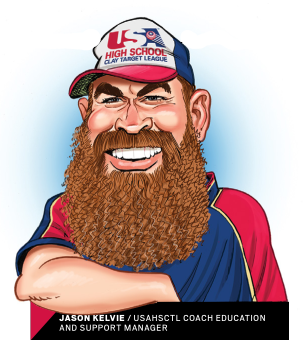
Nothing compares to that feeling of watching the target break as you complete the perfect shot. It’s something we strive for with every squeeze of the trigger. Many people don’t realize how important training your vision is for consistently breaking targets. Learning how to focus and track your target are key techniques for training your vision for better scores.

TRACKING THE TARGET
It’s important that you equip yourself with the skills and knowledge to properly track a target to its breaking point. You want to take the guesswork out of breaking clays, and by learning to track targets you gain a better understanding of consistent flight paths. You can improve your reaction time by watching as many thrown targets as you can. A great way to practice tracking is by watching other squads shoot. Focus on picking up the target as it leaves the thrower and watching it until it’s either broken or has landed on the ground.
Tracking targets without a shotgun can be as simple as the following:
• Watching any target thrown from its launch to landing point
• Pointing at the target with your finger during its flight
• Tracking any side to side movement
• Tracking any close movement going away from you

SOFT FOCUS VS HARD FOCUS
The amount of daylight, the background, and the weather can all affect your vision and how easily you can spot targets as they exit the trap. Regardless of the conditions, we need to have a consistent process for seeing the target through the shot. Knowing the difference between ‘soft focus’ and ‘hard focus’ is really helpful for tracking targets. Imagine looking out at a landscape—your eyes are seeing a large amount of area, but they’re not focused on a specific point. This is what’s called ‘soft focus.’ Now imagine focusing on a specific point on that landscape, such as a building or a tree. Your eye has now adjusted to focus tightly on that point, that’s called ‘hard focus.’ A soft focus of your eyes around the area of where the target is being thrown allows your peripheral vision to monitor a larger space for target movement and will allow you to pick up the target from any direction. This also allows you to start swinging the shotgun earlier, making it easier to track and follow through on your shot.

PRACTICING SOFT AND HARD FOCUS Your eyes can easily switch from soft to hard focus, but your reaction time will be slower if your eyes have to switch from hard, to soft, to hard focus again. That’s why it’s important to practice. You can do this at home by grabbing a partner and a frisbee. Have your partner kneel on the ground roughly ten yards away from you, facing away so that you can’t see which way they’re going to throw the frisbee. You should soft focus in their general area as you call for the frisbee to be thrown, and then hard focus on the frisbee as it flies. Over time and through consistent practice you will find it easier to soft focus in a general area, and lock on to your target quicker and more consistently.




